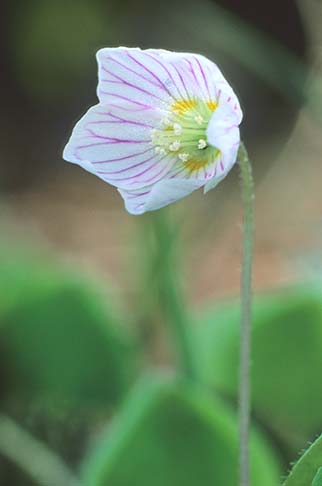Wood-sorrel (Oxalis acetosella)
When: In flower from March - May
How many: Fairly widespread although not often abundant

Look out in springtime New Forest woodlands for the dainty blooms and foliage of wood-sorrel. Wood-sorrel is nowhere abundant – grazing by commoners’ stock, and deer sees to that - but it is tolerant of the often acid New Forest soils, and can often be found in small numbers.
Slender, red-tinged wood-sorrel stems rarely grow to more than a few inches high. Each supports a single, delicate creamy-white, bell-shaped flower. A series of thin lilac or mauve veins runs from the outer edge to deep inside the cup, cleverly designed to tempt tiny, passing insects onto the creamy-white anthers contained within.
Wood-sorrel flourishes before the trees come into leaf, making a dash for growth in early spring. But somewhat unusually, spring-time wood-sorrel flowers bear little seed, and others far less noticeable follow-on to help maintain the species.
Borne in mid-summer on shortened stalks, these prolific new wood-sorrel blooms, however, rarely open, for they are self-pollinating, and have no need for insect help. In late-summer and early autumn they develop egg-shaped fruits that explode when ripe, catapulting out their cargo of tiny, orange seeds.
Wood-sorrel jealously protects its nectar and pollen from damaging weather conditions, for as light levels fall, signaling the on-set of evening or rain, the flowers close tightly shut, opening again only when the light improves. Thin, heart-shaped leaflets at this time also close and droop beside the stem, conserving energy for later photosynthesis when the light returns.
Similarly, when exposed to excess direct sunlight, wood-sorrel leaves again fold tightly back, providing effective protection from undue evaporation and overheating.
Wood-sorrel leaves have a sharp, acidic taste, and, from at least the 15th century, were cultivated for use in salads. W.T. Fernie, writing in the late 19th century, also noted that ‘The herb has been long popular … for making a fever drink, which is thought to be somewhat sedative to the heart, and for helping to cure scurvy. Also, it has proved useful against intermittent fever.’
Reflecting the plant’s appearance, taste and habits, country people called wood-sorrel fairy bells, sour clover, sour grass, sleeping clover, sleeping beauty and also cuckoo flower – wood-sorrel blooms at around the same time as the first cuckoos are heard.
Perhaps the most charming name of all, though, was Alleluia, which, according to William Turner writing in 1568, was given ‘because it appeareth about Easter when Alleluya is song agayn’.
References:
The Wild Flowers of Britain and Northern Europe: Richard Fitter, Alastair Fitter and Marjorie Blamey
Reader’s Digest Field Guide to the Wild Flowers of Britain
The Englishman’s Flora: Geoffrey Grigson
Herbal Simples Approved for Modern uses of Cure: W.T. Fernie
More links
Other related links
Search this site

Sadly, 58 animals were killed - 35 ponies, 13 cows, 8 donkeys and 2 sheep, whilst a further 32 were injured - 3 pigs, 9 donkeys, 11 cows and 9 ponies.
(Forty-three accidents occurred in daylight, 15 at twilight and 101 in the dark. Twenty-seven accidents were not reported by the driver involved).
Here's just one horrific example - Three donkeys killed in collision with van at notorious New Forest blackspot (Advertiser and Times)

